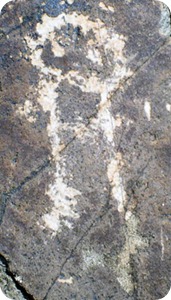Posted by Hugo Rep
Posted on March 30, 2013
with No comments
 For indigenous peoples, the rock art was a tool for communication, a way of transferring ideas, experiences and convictions, as a way to reassert itself and involving other groups put that message in the vastness of the landscape with the intention conscious of that last in space and in time.
For indigenous peoples, the rock art was a tool for communication, a way of transferring ideas, experiences and convictions, as a way to reassert itself and involving other groups put that message in the vastness of the landscape with the intention conscious of that last in space and in time.
In turn, it was a way of intervening territorially-especially when we understand the condition of their producers nomadic referring their inter actions related to space: territorial exploration in search of material resources and the ritualization geographic spaces.
Therefore, the human figure in rock art can not be interpreted as a pictorial representation is much more than that.
 The worldview of American native peoples include animate beings and inanimate elements, all part of an integrated whole that carries the sacred character.
Man fell within that whole.
That sacredness was rooted in naturalistic and mystical thought of the people also hierarchized and deeply respected characters of power within the community.
The worldview of American native peoples include animate beings and inanimate elements, all part of an integrated whole that carries the sacred character.
Man fell within that whole.
That sacredness was rooted in naturalistic and mystical thought of the people also hierarchized and deeply respected characters of power within the community.
This hierarchy is reflected in all the rock art. Thus, some human figures are, the smaller sizes schematic simplicity compared with those showing power attributes, differing both in the set.
But whatever their appearance, the human figure in rock art, is always based on an idea conceived by the thought of the original peoples naturalist who considered their kind in a part of nature and not the shaft system, which is the most widespread conception in our contemporary Western thought.
If you liked this article, subscribe to the feed by clicking the image below to keep informed about new contents of the blog:
I hope you enjoyed this book. If you have any questions, or want to supplement this post, please write in the comments area. You can also visit Facebook, Twitter, Linkedin, Instagram, Pinterest and Feedly where you'll find further information in this blog. SHARE THIS!














0 comments:
Post a Comment
Do not insert clickable links or your comment will be deleted. Check the Notify me notifications to be notified via email of new comments. If I helped you with the post or with the answers to the comments, share on Facebook or Twitter. Thank you.